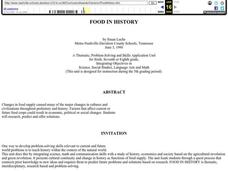Curated OER
Solutions and Suspensions
Learners explore matter by conducting an in class demonstration. In this liquid mixture lesson, students identify the difference between a solution in which a solid dissolves into liquid, and a suspension where the solid doesn't dissolve...
Curated OER
ESL Activity - Authentic Cooking Experience
Students encounter imperatives used for the instructions for this cooking experience. They review selected vocabulary terms for food and the process of cooking. Students identify adverbs of sequence (first, then, etc.). They follow the...
Curated OER
Yeasts and Molds: Food Science, Bacteria, Fungi
In this instructional activity learners will consider the characteristics and nature of yeast and molds in order to help them understand how these microorganisms affect food production.
Education World
Hot Chocolate Testing
In this set of science experiment worksheets, learners examine and record nutrition information from a number of labels off of hot chocolate mixes. They follow follow the directions to participate in a taste and dissolving ability tests...
Curated OER
Our Food and Microorganisms
Students answer questions about how microorganisms can affect our food supply and how they can be controlled. The first set of inquiry activities are directed by the teacher. Subsequent activities are based on students generating their...
Curated OER
A Tasty Experiment
Students work together to determine if smell is important to being able to recongize food by taste. They try different foods with different textures and hold their nose. They create a graph of their results.
Curated OER
Testing Foods
Students perform an experiment using brown paper bags to determine which foods have oil in them. This task assesses student's abilities to make simple observations and inferences from them.
Curated OER
Energy Content Of Foods And Fuels
High schoolers engage in a study of food and how it used as fuel for the human body. They research how biological systems require energy and compare them to the physical science systems like machines. They compare and contrast what they...
Curated OER
Food Matters
Fifth graders identify physical and chemical changes. In this science inquiry lesson, 5th graders observe the changes that occur when making bread and butter. Students explain if the product is result of a physical or chemical change.
Curated OER
Food in History
Students research, predict and offer solutions regarding factors that affect current or future food crops could result in economic, political or social changes.
Curated OER
Funky Food Farm
Students research about ways to keep food from spoiling. In this health science lesson, students design an experiment to keep the ice cubes from melting. They present their designs and results in class.
Curated OER
Experiments
In this experiments worksheet, students determine the weight and mass of different objects. Students review variables in an experiment. This worksheet has 8 short answer questions and 11 problems to solve.
Curated OER
Food and Fiber: Helping the Environment and You
Fourth graders explore the many uses of corn-based products and the importance of water resources. They consider how biodegradable products help to keep water clean. They perform experiments to observe how corn pellets dissolve while...
Curated OER
Science: Testing Water for Toxicity
Students investigate the potential toxicity of water samples using California blackworms to test water quality. They observe the worms' behaviors in different water samples and determine which sample has the highest toxicity. At the...
Curated OER
Science: Let's Be Molecules!
Students discover how molecules are in constant motion. Through a simple experiment of water containing food coloring, they observe the drops of coloring move even though the water is still. Role-playing as molecules, students stand up...
Curated OER
Photosynthesis: An enlightening experience
Students observe the effect of light on plants. They illustrate the exchange of gases between the atmosphere and the plant. Students see that plants are part of many natural cycles. They investigate how green plants use the sun's energy...
Curated OER
How to Design an Experiment
Students work together to develop and implement an experiment. They investigate the properties of nylon and construct a mobile of organic materials. They share their experiments with the class.
Curated OER
Charlotte and Her Relatives Visit the Classroom: Spider Activities, Experiments and Projects
Learners compare and contrast different spider species that they capture and maintain in the classroom for several days. They identify and research the species characteristics and living requirements then conduct an experiment on spider...
American Museum of Natural History
Finding Fossils
How does one go about finding fossils? Find out with an informative webpage that looks at the digging process, showcases rocks and common fossils, helpful tips, and a list of archeological do's and don'ts.
National Wildlife Federation
Gator Hole Graphics
Climate changes are cyclic so how do these changes impact species that live in different habitats? Learners examine the rainfall levels in a specific swamp habitat. They also review graphical data and tell a story about how the levels...
Curated OER
Yeasts and Molds
Students investigate the characteristics and nature of yeast and molds help to explain how these microorganisms affect food production. They experiment with yeast in sourdough in preparing sourdough pancakes.
Curated OER
TE Lesson: Can You Taste It?
Students investigate how animals adapt to use its senses to identify foods that are nutritious or noxious. They determine how they associate foods with other things such as birthdays. They discuss the role of the nervous system in the...
Curated OER
Capillary Action and Adhesion
Students perform classroom experiments to observe adhesion. They perform a second experiment using sand, salt, water, and a heat lamp to observe the principle of capillary action. They also experiment with adhesion in plants.
Curated OER
Oxidative Rancidity in Potato Chips
In this oxidative rancidity instructional activity, students conduct an experiment on potato chips. Students complete 4 short answer questions upon completing the experiment.

























